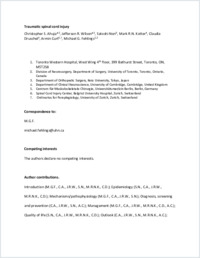Traumatic spinal cord injury.
- Ahuja CS Division of Neurosurgery, Department of Surgery, University of Toronto, Toronto, Ontario, Canada.
- Wilson JR Division of Neurosurgery, Department of Surgery, University of Toronto, Toronto, Ontario, Canada.
- Nori S Department of Orthopedic Surgery, Keio University, Tokyo, Japan.
- Kotter MRN Department of Clinical Neuroscience, University of Cambridge, Cambridge, UK.
- Druschel C Centrum für Muskuloskeletale Chirurgie, Universitätsmedizin Berlin, Berlin, Germany.
- Curt A Spinal Cord Injury Center, Balgrist University Hospital, Zurich, Switzerland.
- Fehlings MG Division of Neurosurgery, Department of Surgery, University of Toronto, Toronto, Ontario, Canada.
- 2017-04-28
Published in:
- Nature reviews. Disease primers. - 2017
Electric Stimulation Therapy
Glucocorticoids
Humans
Hypotension
Magnetic Resonance Imaging
Methylprednisolone
Quality of Life
Radiography
Spinal Cord Injuries
Spine
Syringomyelia
Tomography, X-Ray Computed
Wounds and Injuries
English
Traumatic spinal cord injury (SCI) has devastating consequences for the physical, social and vocational well-being of patients. The demographic of SCIs is shifting such that an increasing proportion of older individuals are being affected. Pathophysiologically, the initial mechanical trauma (the primary injury) permeabilizes neurons and glia and initiates a secondary injury cascade that leads to progressive cell death and spinal cord damage over the subsequent weeks. Over time, the lesion remodels and is composed of cystic cavitations and a glial scar, both of which potently inhibit regeneration. Several animal models and complementary behavioural tests of SCI have been developed to mimic this pathological process and form the basis for the development of preclinical and translational neuroprotective and neuroregenerative strategies. Diagnosis requires a thorough patient history, standardized neurological physical examination and radiographic imaging of the spinal cord. Following diagnosis, several interventions need to be rapidly applied, including haemodynamic monitoring in the intensive care unit, early surgical decompression, blood pressure augmentation and, potentially, the administration of methylprednisolone. Managing the complications of SCI, such as bowel and bladder dysfunction, the formation of pressure sores and infections, is key to address all facets of the patient's injury experience.
- Language
-
- English
- Open access status
- green
- Identifiers
-
- DOI 10.1038/nrdp.2017.18
- PMID 28447605
- Persistent URL
- https://sonar.ch/global/documents/271108
Statistics
Document views: 13
File downloads:
- fulltext.pdf: 0
